Richard Willis here from M&R Specialty Trailers and Trucks. After building custom BBQ units for over two decades, I’ve learned a lot about what makes these businesses run profitably. Let me walk you through the process step by step with some insider knowledge on building and marketing your mobile BBQ operation.
Step 1: Planning Phase (6-12 Months)
Initial Planning (Months 1-3)
Before you even think about buying equipment, you need a rock-solid plan. Here’s what needs to happen in your first three months:
-
- Are you in a region with a strong BBQ identity (like Kansas City or Texas)?
- What styles are currently represented in your market?
- Is there an opportunity to introduce a new regional style?
Builder’s Tip: When building units for different BBQ styles, I customize the smoker configuration accordingly. For Texas-style operations, I install larger fireboxes suitable for oak logs, while Kansas City-style usually gets a more compact design optimized for wood chunks and temperature control.
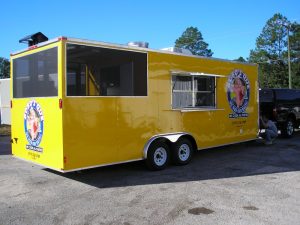
Built by M&R Specialty Trailers and Trucks.
Market Research
Let’s dive deep into understanding your market. First things first, scope out your competition.
Hit the streets or go online and make a list of all the BBQ joints and food trucks in town. Pop in during their busy hours and peek at what people are ordering. Are they chowing down on brisket sandwiches or pulled pork platters? Jot down those menu items and prices. According to a recent survey by Food Truck Empire, 78% of successful food truck owners studied their competitors before launching. Smart move, right? You should do the same. Plus it’s easier than ever thanks to the amount of research you can conduct online.
Next up, dive into the local event scene. Check out websites like Eventbrite and Facebook to see what food festivals, corporate shindigs, and other gatherings are happening in your area. Don’t forget about breweries, wedding venues, and sports stadiums too. These are all prime spots to park your truck and serve up some mouthwatering BBQ. Did you know that food trucks that partner with breweries can boost their sales by up to 30%? That’s a lot of extra dough!
Now, let’s talk about your future customers. What are they craving and how much are they willing to spend? Scope out the local restaurant scene to get a feel for popular price points. If you’re in a higher-income area, you might be able to charge a bit more for those gourmet BBQ plates. But if you’re catering to a lunch crowd, keep things affordable and easy to eat on the go.
Oh, and don’t forget about dietary preferences! More and more people are looking for turkey, chicken, and veggie options these days. In fact, a recent report by the National Restaurant Association found that 70% of millennials are more likely to visit a restaurant that offers healthy menu items. So, consider adding some lighter fare to your menu to keep everyone happy.
Business Concept Development
Alright, let’s talk BBQ styles! This is where you really get to let your creativity shine and make your food truck stand out from the rest.
First up, we’ve got the regional classics. If you’re a fan of Texas-style BBQ, you’ll want to focus on nailing that perfect brisket and beef ribs. Keep the sauce on the side and let the meat speak for itself. Kansas City, on the other hand, is all about those sweet, thick sauces and a variety of meats. Memphis-style is known for its dry rub ribs and pulled pork, while Carolina BBQ is all about the tangy vinegar or mustard-based sauces on pulled pork. And let’s not forget about Alabama’s unique white sauce, which is a must-try on smoked chicken.
But hey, who says you have to stick to the classics? Why not get a little wild with some modern fusion concepts? BBQ tacos are a crowd-pleaser, combining the best of both worlds. Or how about some Asian-BBQ fusion, with flavors like hoisin, gochujang, or teriyaki? BBQ bowls are another trendy option, layering your favorite meats and sides for a satisfying all-in-one meal. And for the health-conscious crowd, consider offering some lighter options like grilled chicken or turkey, along with fresh veggie sides.
BBQ Style Options:
Regional Styles:
- Texas-style: Focus on brisket, beef ribs, minimal sauce
- Kansas City: Sweet, thick sauces, variety of meats
- Memphis: Dry rub ribs, pulled pork
- Carolina: Pulled pork with vinegar or mustard sauce
- Alabama: White sauce chicken focus
Modern Fusion Concepts:
- BBQ Tacos
- Asian-BBQ fusion
- BBQ Bowls
- Healthy BBQ (lean meats, lighter sides)
Builder’s Tip: For fusion concepts, I recommend dual prep stations with separate ventilation systems. This prevents cross-contamination of smoke flavors when you’re working with different cuisine styles. I also install additional power outlets for specialized equipment like rice cookers or wok stations.
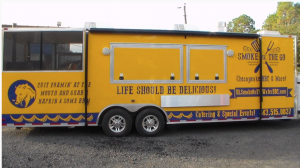
Smoke on the Go BBQ.
Service Style Options:
If you’re all about speed and efficiency, quick service might be the way to go. Think sandwiches, wraps, and pre-portioned plates that are easy to grab and go. Keep your sides simple and limited to just a few fan favorites. This style is perfect for busy lunchtime crowds or high-traffic events where people want to get their grub and get back to the action.
On the flip side, if you’re more about that low-and-slow tradition, you might prefer a classic meat-by-the-pound setup. Let your customers pick their favorite cuts and load up on sides family-style. This is a great option if you’re parked at a more laid-back venue or catering a big group event. Just make sure you’ve got plenty of napkins on hand for those saucy fingers.
Quick Service:
- Sandwiches and wraps
- Pre-portioned plates
- Limited sides
Traditional Service:
- Meat by the pound
- Family-style service
- Multiple sides
Specialty Focus:
- Catering only
- Event-focused
- Corporate lunch specialist
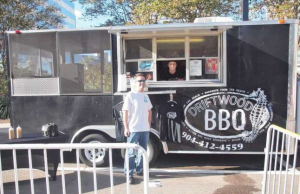
Built by M&R Specialty Trailers and Trucks
Menu Development
Alright, let’s talk menu strategy! Your core BBQ items are going to be the backbone of your business, so let’s break it down.
First up, brisket. This is a must-have for any serious BBQ joint. Offer both lean and moist cuts to cater to different preferences. A 2022 survey by Texas Monthly found that brisket is the most popular BBQ meat in the state, with 47% of respondents choosing it as their favorite.
Next, pulled pork. This is a classic crowd-pleaser that’s easy to serve up in sandwiches or on plates. According to a report by the National Pork Board, pulled pork has seen a 20% increase in popularity over the last decade.
Core BBQ Items:
- Brisket (choice of lean or moist)
- Pulled Pork
- Ribs (spare or baby back)
- Chicken (quarters or halves)
- Sausage links
Now, let’s talk signature items. This is where you can really let your creativity shine and set yourself apart from the competition. Burnt ends are a classic option – these flavorful morsels of brisket are often served as an appetizer or sandwich filling. Smoked wings are another fan favorite, and you can experiment with different rubs and sauces to make them your own.
Specialty sandwiches are a great way to showcase your unique style. Think brisket grilled cheese, pulled pork with coleslaw, or a spicy sausage and pepper hoagie. And don’t forget about your sauces! Develop a few signature blends that complement your meats perfectly.
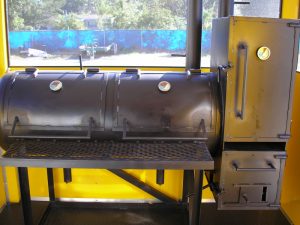
BBQ Smoker setup.
Signature Items Examples:
- Burnt ends
- Smoked wings
- Specialty sandwiches
- Unique sauces
When it comes to sides, you’ve got plenty of options. Traditional favorites like coleslaw, beans, and potato salad are always a hit. But why not elevate those classics with some creative twists? Jalapeño mac and cheese or bourbon baked beans are sure to impress. And don’t forget about your health-conscious customers – offer some grilled veggies or a light vinegar slaw to balance out all that smoky goodness.
Sides Strategy:
- Traditional (coleslaw, beans, potato salad)
- Elevated classics (jalapeño mac & cheese, bourbon baked beans)
- Health-conscious options (grilled vegetables, vinegar slaw)
Finally, let’s talk pricing. You’ll want to have a range of options to suit different budgets and appetites. Quick lunch items in the $10-15 range are perfect for the midday crowd. Individual plates from $15-25 will be your bread and butter for dinner service. Family packs from $50-100 are great for larger groups or catering gigs. And don’t forget about bulk meat by the pound – this is a must-have for any serious BBQ operation.
Pricing Tiers:
- Quick lunch items ($10-15)
- Individual plates ($15-25)
- Family packs ($50-100)
- Bulk meat by the pound
Builder’s Tip: Your menu directly impacts your equipment needs. For example, if you’re doing high-volume brisket, I recommend a separate holding cabinet just for brisket to maintain proper temperature and moisture levels.
Daily Operations Planning
Alright, let’s dive into the nitty-gritty of your smoking schedule and equipment needs. First things first, let’s talk about timing. Here’s a sample smoking schedule that’ll help you stay on track and ensure everything’s ready for service:
Smoking Schedule Example:
- 8pm: Start brisket smoke
- 12am: Add pork butts
- 4am: Add ribs
- 6am: Add chicken
- 8am: Start sides prep
- 11am: Ready for service
Equipment Needs Based on Menu:
- Primary smoker capacity
- Hot holding equipment
- Cold storage requirements
- Prep space allocation
Builder’s Tip: Your concept directly impacts your equipment needs. For example, if you’re focusing on brisket, you’ll need a different smoker setup than if you’re primarily doing pulled pork. We can help you determine the right equipment to install based on your menu and needs.
Business Planning (Months 3-6)
- Financial Planning
- Create detailed budget
- Research funding options
- Develop pricing strategy
- Project cash flow for first 18 months
- Legal Requirements
- Business registration
- Health permits
- Food handler certifications
- Vehicle permits
- Insurance coverage
Step 2: Equipment Selection and Design (Months 6-9)
Mobile Unit Design
This is where my expertise really comes in handy. Here’s what makes a great BBQ unit:
Let’s talk about the heart and soul of your BBQ food truck: the mobile unit design. As a builder, I’ve seen hundreds of setups, and I’m here to share some insider tips on what makes a truly great BBQ rig.
First and foremost, you gotta nail your layout. It’s all about optimizing that work triangle. You want your cooler, prep area, and smoker all within easy reach. A well-designed layout can shave minutes off your service time and keep your crew happy, efficient, and profitable.
- Layout Considerations
- Work triangle optimization
- Proper ventilation design
- Adequate prep space
- Storage solutions
- Service window placement
Speaking of efficiency, let’s talk ventilation. You’re gonna be pumping out some serious smoke, so you need a ventilation system that can keep up. I always recommend a powerful hood with grease filters and a fire suppression system. Not only will this keep your unit up to code, but it’ll also prevent any nasty grease buildups that could cause problems down the line.
- Equipment Specifications
- Commercial-grade smoker
- Refrigeration units
- Hand washing station
- Hot holding equipment
- Fire suppression system
Smoker Selection
Let’s deep dive into smoker options:
- Custom Commercial Smoker Features
- Multiple temperature zones
- Proper airflow design
- Easy cleaning access
- Fuel efficiency
- Weather protection
Builder’s Tip: For mobile operations, I recommend reverse flow smokers with insulated fireboxes. They’re more fuel-efficient and maintain consistent temperatures even when moving between locations.
Step 3: Operations Setup (Months 9-10)
Supply Chain Management
- Meat Sourcing
- Local suppliers vs. wholesale
- Quality standards
- Delivery schedules
- Storage requirements
- Equipment and Supplies
- Disposables inventory
- Cleaning supplies
- Wood/fuel source
- Backup equipment
Standard Operating Procedures
- Daily Operations
- Opening procedures
- Prep schedules
- Service workflows
- Closing checklists
Marketing Tip: Document your prep process for social media. Customers love seeing behind-the-scenes content of your smoking process. One food truck in Tennessee grew their Instagram following to 50K just by posting daily meat prep videos. People love this stuff.
Step 4: Marketing and Brand Development (Months 10-12)
Marketing and branding. This is where you really get to let your personality shine and connect with your customers on a deeper level.
First up, let’s talk visual elements. Your logo is the face of your brand, so make sure it’s memorable and reflects your unique style. I always recommend working with a professional designer to create a logo that really pops. While you’re at it, nail down your color scheme too. Choose colors that complement your logo and evoke the right emotions for your brand. Bold reds and oranges are great for BBQ, but don’t be afraid to think outside the box.
Brand Identity
- Visual Elements
- Logo design
- Color scheme
- Vehicle wrap design
- Menu board layout
Builder’s Tip: When designing your truck wrap, consider how it looks in photos. I always recommend bold, contrasting colors that pop in social media posts.
Now, let’s talk vehicle wrap design. This is your chance to turn your food truck into a mobile billboard. Work with your designer to create a wrap that showcases your logo, menu, and any other key branding elements. And here’s a pro tip from a builder: make sure your design looks great in photos! You’ll be snapping plenty of pics for social media, so choose bold, contrasting colors that really stand out.
- Digital Presence
- Website development
- Social media setup
- Online ordering system
- Email marketing platform
Marketing Strategy
Now, let’s talk launch planning. You only get one chance to make a first impression, so make it count! Host a series of soft opening events to give your team a chance to work out any kinks before the big day. Invite friends, family, and local influencers to generate some buzz. Then, go all out for your grand opening! Offer special promotions, like a free side with every order or a discount for first-time customers. Reach out to local media outlets and food bloggers to score some coverage.
- Launch Planning
- Soft opening events
- Grand opening promotion
- Media outreach
- Influencer partnerships
- Ongoing Marketing
- Content calendar
- Social media management
- Customer loyalty program
- Event participation
Marketing Tip: Create Instagram-worthy moments in your service. I built a unit with a glass viewing window where customers could watch the pitmaster at work – it became a huge social media draw.
But the work doesn’t stop after launch day. You’ll need an ongoing marketing strategy to keep the momentum going. Create a content calendar to plan out your social media posts and email newsletters in advance. Make sure you’re constantly engaging with your followers and responding to any comments or messages. You could even start a customer loyalty program to reward your regulars with exclusive perks and discounts.
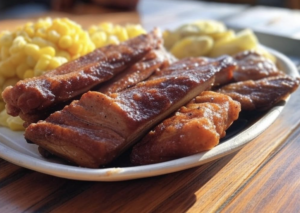
Serving up a classic BBQ plate.
Step 5: Location and Service Strategy
et’s talk about location, location, location! Where you park your BBQ truck can make all the difference in your success.
First up, let’s talk regular service spots. Business districts are a no-brainer. You’ve got a built-in lunch crowd of hungry office workers looking for a tasty meal to break up their day. Plus, if you can score a spot near a popular park or outdoor area, you’ll be in prime position for the summer picnic crowd.
Prime Locations
- Regular Service Spots
- Business districts
- Brewery partnerships
- Food truck parks
- Corporate campuses
- Event Circuit
- Food festivals
- Music events
- Private catering
- Corporate events
Brewery partnerships are another smart move. Craft beer and BBQ go together like peanut butter and jelly. See if you can team up with a local brewery to park outside during their busy hours. You’ll benefit from their foot traffic, and they’ll love having a food option for their hungry patrons. It’s a win-win!
Builder’s Tip: Consider your location when designing your unit. For street service, I recommend a passenger-side service window to ensure customer safety. For events, a larger awning and multiple service windows can handle higher volume.
Step 6: Launch and Early Operations
Let’s talk about those crucial first 30 days. This is where all your hard work and planning finally comes to fruition, and it’s time to hit the ground running.
Before you even think about opening your doors (or your service window, in this case), there’s some serious prep work to be done. First and foremost, you gotta train your staff. These are the folks who’ll be the face of your business, so you want to make sure they know their stuff. Take the time to go over your menu, your recipes, and your customer service expectations. Role-play some common scenarios and make sure everyone’s on the same page.
First Month Checklist
- Pre-Launch
- Staff training
- Menu testing
- Equipment testing
- Soft opening feedback
- Launch Phase
- Limited menu to start
- Focused marketing push
- Customer feedback collection
Of course, you’ll also want to put your equipment through its paces. Fire up that smoker and make sure it’s holding steady temps. Test your refrigeration units and make sure they’re keeping things cool. The last thing you want is a breakdown on opening day.
Builder’s Tip: For your training period, I recommend installing temporary cameras in key workflow areas. This lets you review and optimize your processes before finalizing the layout. Several of my clients have saved thousands in renovation costs by identifying workflow issues during their soft opening.
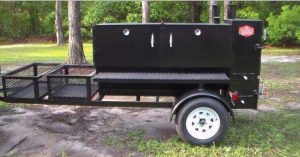
Built by M&R Specialty Trailers and Trucks.
Technical Specifications for a Successful BBQ Unit
Running heavy-duty equipment requires a power setup that can handle the load. A minimum of 50 amp service with multiple circuits is recommended to avoid overloading. A generator backup is essential for off-grid operation, and solar panels can provide auxiliary power. Losing power during a busy service can be detrimental to your operation.
Essential Build Features
Power Systems
- 50 amp service minimum (variable requirement based on your needs)
- Multiple circuit design
- Generator backup
Next, water systems are crucial. A 50-gallon freshwater tank is the minimum recommendation, along with a gray water tank to handle wastewater. A hot water heater is necessary for dishwashing and other cleaning tasks. To comply with health codes, a multiple sink setup is required, including a three-compartment sink for washing, rinsing, and sanitizing, as well as a separate handwashing sink for the crew.
Water Systems
- 50-gallon freshwater tank
- Gray water tank
- Hot water heater
- Multiple sink setup
Proper ventilation is often overlooked in BBQ trucks, but it is crucial. The high volume of smoke produced requires a ventilation system with extra CFM capacity. A hood system with fire suppression, a make-up air system to replace exhausted air, and strategically placed exhaust fans are necessary to optimize air flow. Investing in a proper ventilation system ensures the comfort and safety of both your crew and customers.
Ventilation
- Hood system with fire suppression
- Make-up air system
- Exhaust fan placement
- Air flow optimization
Builder’s Tip: Proper ventilation is crucial for BBQ units. I design systems with additional CFM capacity to handle heavy smoke production.
Finally, storage solutions are essential for organizing ingredients and supplies. For cold storage, a combination of reach-in refrigerators, under-counter coolers, and ice bins can be used to keep items chilled. Refrigerated prep tables are also recommended to maintain the freshness of meats and vegetables during service.
- Cold Storage
- Reach-in refrigerator
- Under-counter coolers
- Ice bins
- Prep table refrigeration
- Dry Storage
- Ingredient bins
- Utensil organization
- Disposables storage
- Equipment storage
Final Thoughts
Remember, success in the mobile BBQ business comes down to three things: great equipment, solid operations, and strong marketing. Take your time in the planning phase, invest in quality equipment, and never stop improving your processes.
If you need specific advice about custom BBQ units or want to discuss your mobile BBQ business plans, feel free to reach out. After 20+ years in this business, I’m always happy to help fellow BBQ enthusiasts turn their passion into a successful business.

Leave A Comment